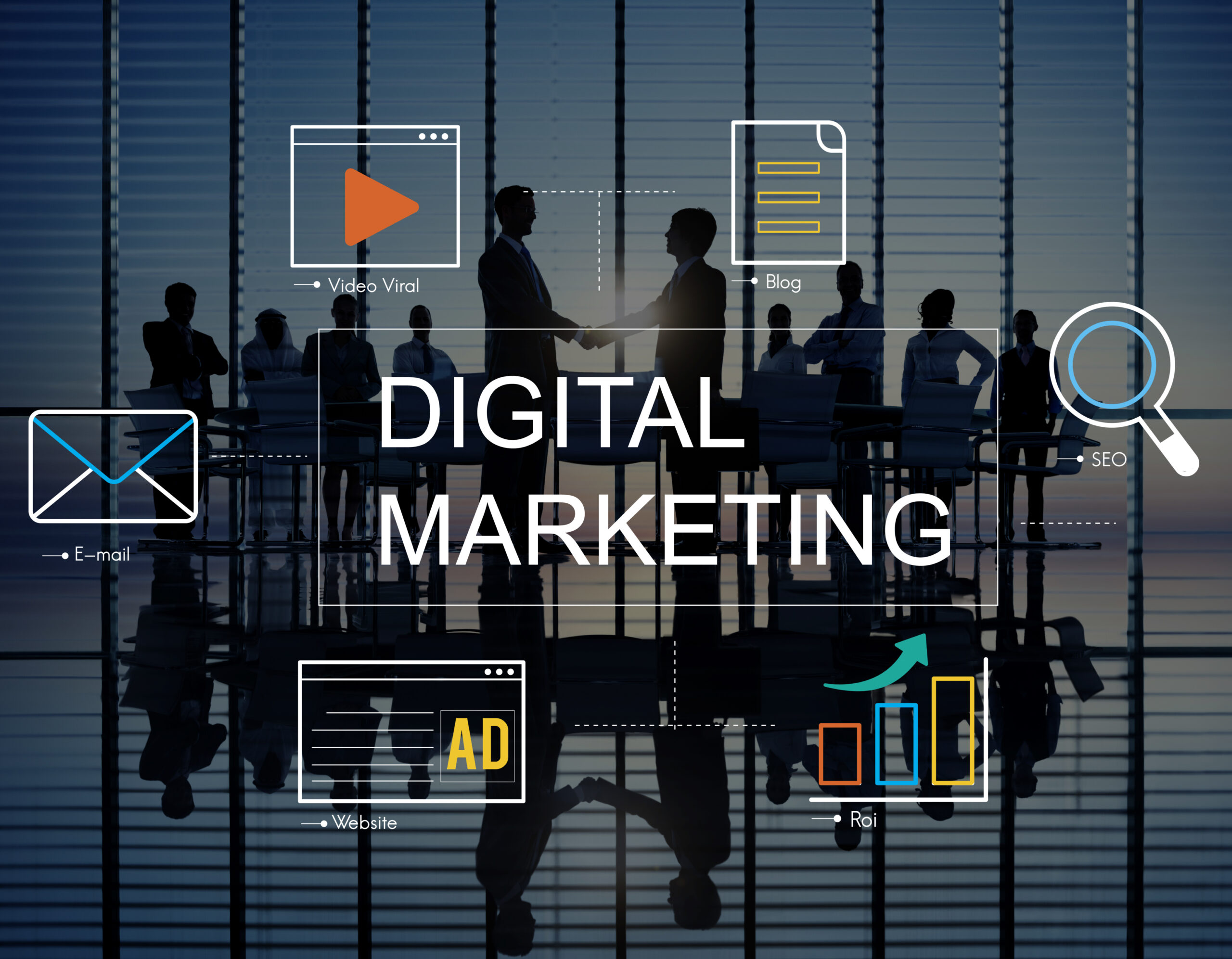How Does Digital Marketing Grow Your Business?

In today’s digital age, ignoring online marketing is like sailing blindfolded. Consumers navigate a sea of information online, seeking personalized experiences and tailored solutions. Digital marketing becomes your compass, guiding you to connect with them on their terms, build trust, and drive growth. It’s not just a marketing tactic; it’s a survival imperative for businesses to thrive in this vibrant, ever-connected world. So, embrace the digital revolution and let your brand shine on the internet.

Reaching New Customers and Targeting Audiences
The Power of the Internet: Shattering Borders and Reaching Millions
Imagine a world where your brick-and-mortar shop instantly morphs into a global megastore, accessible to millions across continents. This is the transformative power of the internet, revolutionizing how businesses reach and engage potential customers. Geographical limitations crumble, language barriers fade, and time zones become irrelevant. With digital marketing, your brand transcends physical boundaries, casting its net across the vast ocean of online users.
Expanding Reach Beyond Geographical Walls:
Forget the confines of local streets and regional campaigns. The internet grants you access to a global audience, opening doors to markets you once thought unimaginable. Picture yourself connecting with customers in bustling Tokyo, sun-soaked Sao Paulo, or remote villages in the Himalayas – all from the comfort of your digital headquarters. This opens doors to new revenue streams, diversifies your customer base, and injects a healthy dose of cultural diversity into your business.
Targeting Specific Demographics and Interests:
But the internet’s power goes beyond mere reach. Unlike traditional marketing’s shotgun approach, digital marketing allows you to pinpoint your ideal customers with laser precision. Imagine identifying users based on their age, income, location, online behavior, and even niche interests. You can tailor your message to resonate with their specific needs and aspirations, creating a personalized experience that fosters trust and engagement.
Think of it as hosting a global cocktail party where you invite only guests who share your passions. You can craft the perfect conversation starters, recommend products they’ll genuinely appreciate, and build relationships that extend beyond the fleeting moment of the virtual encounter. This targeted approach translates to higher conversion rates, increased brand loyalty, and a deeper understanding of your customer base.
Understanding Your Audience: The Key to Unlocking Marketing Magic
Reaching your target audience is one thing, but truly connecting with them requires an intimate understanding of their online persona. This is where audience research becomes your secret weapon, allowing you to peel back the layers of demographics and delve into their desires, fears, and aspirations.
Defining Your Ideal Customer Persona:
Imagine creating a detailed portrait of your perfect customer. What are their online habits? What websites do they frequent? What kind of content do they consume? Answering these questions helps you build a comprehensive persona, a fictional representation of your ideal audience that guides your every marketing decision.
Researching Online Behavior and Preferences:
Don’t just guess what your audience wants; listen to their digital whispers. Utilize social media listening tools, track website analytics, and analyze search engine trends to understand their online behavior and preferences. This data paints a vivid picture of their interests, pain points, and preferred communication channels, allowing you to tailor your marketing messages accordingly.
Segmentation Strategies for Focused Marketing Efforts:
Instead of broadcasting a generic message to the masses, consider segmenting your audience based on their shared characteristics or online behavior. Imagine dividing your customer base into groups like “fitness enthusiasts,” “tech-savvy professionals,” or “budget-conscious travelers.” This allows you to personalize your approach for each segment, ensuring your message resonates and drives engagement.
Channels for Targeting and Acquisition: A Multifaceted Approach
Think of your audience as scattered across a vast archipelago, each island representing a different online platform. With digital marketing, you build bridges to each island, creating diverse channels for reaching and engaging your target audience.
Search Engine Optimization (SEO): The Organic Magnet:
Imagine your website as a beacon in the vast ocean of online content. SEO optimizes your website and content to rank higher in search engine results, attracting organic traffic from users actively searching for keywords related to your brand or offerings. It’s like building a lighthouse that guides potential customers directly to your doorstep.
Pay-Per-Click (PPC) Advertising: Targeted Promotions on Demand:
Think of PPC as billboards on the digital highways of the internet. You bid on specific keywords and phrases, ensuring your ad appears prominently on search engine results pages or relevant websites. This targeted approach allows you to reach users actively searching for your products or services, increasing your visibility and driving immediate conversions.
Social Media Marketing: Building Communities and Engaging Your Tribe:
Imagine creating a vibrant online town square where your brand is the central attraction. Social media platforms like Facebook, Instagram, and Twitter allow you to build engaged communities, share valuable content, and foster genuine connections with your target audience. This organic interaction fosters brand loyalty, drives word-of-mouth marketing, and ultimately leads to conversions.
Content Marketing: Educating and Attracting with Valuable Insights:
Content marketing transforms your brand from a mere seller into a trusted resource. By creating informative blog posts, engaging videos, insightful ebooks, and captivating infographics, you position yourself as an expert in your field, attracting potential customers seeking solutions to their problems. This valuable content nurtures leads, builds trust, and ultimately converts them into loyal customers
Influencer Marketing: Leveraging Credibility and Reach:
Think of influencers as celebrities of the digital age, wielding immense power over their dedicated online following. By partnering with established personalities in your niche, you tap into their audience trust and leverage their reach to promote your brand. Imagine a fitness influencer showcasing your activewear line in their workout videos or a travel blogger featuring your eco-friendly travel products in their blog posts. These strategic collaborations can exponentially increase brand awareness, drive targeted traffic, and boost conversion rates.
Email Marketing: Cultivating Relationships and Nurturing Leads:
Don’t underestimate the power of personalized email communication. Building an email list allows you to nurture leads through targeted campaigns, offering valuable content, exclusive discounts, and timely updates. Imagine sending email sequences that guide potential customers through their buying journey, providing educational resources at each stage and gently nudging them towards conversion.
Affiliate Marketing: Collaborating for Mutual Success:
Think of affiliate marketing as a mutually beneficial partnership. You partner with other websites or bloggers who promote your products or services in exchange for a commission on each sale generated through their platform. This allows you to tap into their established audience and leverage their existing relationships to expand your reach without significant upfront investment.
Measuring and Analyzing Reach and Acquisition: Data-Driven Insights for Success
Reaching and acquiring new customers is just the first step. The true art of digital marketing lies in measuring your efforts and optimizing your strategies based on data-driven insights.
Key Metrics for Tracking Reach and Acquisition:
Imagine your dashboard as a control center for your online empire. Track key metrics like website traffic, leads generated, conversion rates, and customer acquisition cost to understand the effectiveness of your campaigns. By analyzing these numbers, you gain valuable insights into what’s working and what’s not, allowing you to refine your strategies for maximum impact.
Tools and Analytics Platforms: Your Digital Spyglass
Don’t rely on guesswork; arm yourself with powerful analytics tools like Google Analytics, social media Insights platforms, and email marketing reporting dashboards. These tools provide in-depth reports and visualizations, allowing you to track user behavior, analyze campaign performance, and identify areas for improvement.
Optimizing Strategies Based on Data-Driven Insights:
Imagine being able to tweak your marketing campaigns like a seasoned musician fine-tuning their instrument. Based on your data analysis, you can adjust your SEO keywords, refine your PPC bids, experiment with different social media post formats, and personalize your email content for better engagement. Remember, data is your compass, guiding you towards strategies that resonate with your audience and drive optimal results.
Reaching and engaging new customers in the digital age is not a one-size-fits-all equation. It’s a symphony of tactics, meticulously orchestrated to attract, engage, and convert. By understanding your audience, leveraging the power of diverse online channels, and continuously analyzing your performance, you can transform your brand into a beacon of success in the ever-evolving digital landscape.

Building Brand Awareness and Reputation: Beyond Recognition to Resonance
In the bustling marketplace of the digital age, recognition isn’t enough. Your brand needs to go beyond a catchy name and a sleek logo. It needs to weave itself into the fabric of people’s lives, earning their trust, respect, and ultimately, their loyalty. This is where brand awareness and reputation take center stage, shaping your digital persona and influencing every interaction you have with your audience.
The Importance of Brand Awareness: The Cornerstone of Your Digital Identity
Imagine strolling down a crowded street, bombarded by a cacophony of brands vying for your attention. What makes one shop window stop you in your tracks? It’s awareness – the feeling of familiarity, the promise of a connection, the spark of interest that draws you closer. In the digital realm, awareness plays a similar role. It’s the foundation upon which your reputation is built, the first impression that lingers in minds and influences every subsequent interaction.
Building Trust and Recognition:
Think of awareness as laying the groundwork for trust. When people recognize your brand name, logo, and core values across platforms, they start to perceive you as a familiar face, not a stranger in the digital crowd. This familiarity breeds trust, making them more likely to engage with your content, consider your products, and choose you over competitors.
Differentiating Your Business from the Pack:
In a sea of sameness, awareness becomes your lifebuoy. It allows you to stand out from the generic mass, highlighting the unique values, personality, and purpose that set you apart. By crafting a strong brand identity and consistently communicating it across channels, you carve out a distinct space in the digital landscape, attracting customers who resonate with your story and find value in your offerings.
Influencing Purchasing Decisions:
Ultimately, awareness is the silent nudge that guides decision-making. When people are familiar with your brand, they’re more likely to consider you when a need arises. They subconsciously trust your offerings, associate your name with positive experiences, and feel a sense of connection that transcends price and features. This subconscious influence paves the path to conversion, turning awareness into loyal customers and thriving business.
Strategies for Building a Brand that Resonates:
Building a memorable brand isn’t about shouting the loudest; it’s about crafting a compelling narrative that resonates with your audience. Here are some key strategies to consider:
Consistent Brand Messaging:
Imagine your brand as a well-rehearsed orchestra, every player harmonizing in perfect tune. Consistent messaging across all channels, from your website to your social media posts, ensures your audience receives a clear and unified image of your brand. Use the same voice, tone, and visual identity to foster recognition and solidify your presence in their minds.
Storytelling and Content Marketing:
Humans are hardwired for stories. By weaving narratives into your content marketing, you connect with your audience on an emotional level, drawing them into your brand’s world and showcasing your values in action. Share customer testimonials, feature employee stories, and create behind-the-scenes glimpses to give your brand a relatable face and add depth to your online presence.
Engaging with Customers on Social Media and Online Communities:
Don’t be a bystander on the digital playground. Actively engage with your audience on social media platforms and relevant online communities. Respond to comments, participate in discussions, and host interactive events to create a sense of two-way communication and foster closer relationships. Remember, authenticity is key. Be genuine, transparent, and approachable to build trust and loyalty.
Building Positive Online Reviews and Testimonials:
Word-of-mouth marketing in the digital age takes the form of online reviews and testimonials. Encourage satisfied customers to share their experiences on platforms like Google, Facebook, and industry-specific review sites. Positive feedback adds a layer of social proof, building trust and influencing the decisions of potential customers.
Participating in Relevant Industry Events and Forums:
Step out of the digital world and into the physical. Participate in industry events, conferences, and forums to connect with potential customers, partners, and influencers face-to-face. Showcase your expertise, build relationships, and demonstrate your commitment to your niche, all of which contribute to a positive brand image and increased awareness.
Social Responsibility Initiatives and Community Engagement:
Showcasing your values and giving back to the community is not just the right thing to do; it’s also a powerful brand-building strategy. Get involved in social responsibility initiatives, sponsor local events, and support relevant causes. This engagement creates goodwill, fosters positive brand perception, and connects you to a wider audience who share your values.
Measuring and Analyzing Your Brand’s Impact:
Building awareness and reputation is a continuous journey, not a destination. To ensure your efforts are bearing fruit, you need to measure and analyze your progress.
Brand Mentions and Sentiment Analysis:
Tools like Brand24 or Sprout Social can track mentions of your brand across social media and online platforms, providing valuable insights into sentiment and reach. Analyze the tone of conversations, identify common themes, and gauge the overall perception of your brand. Are people enthusiastic and positive? Do they have concerns or negative experiences they’re sharing online? This data helps you understand your audience’s perspective and refine your brand messaging accordingly.
Website Traffic and Bounce Rates:
Monitor your website traffic, paying close attention to how visitors discover your site and how long they stay. Are they coming from social media channels, organic search, or paid advertising? Do they navigate through your pages with ease or quickly click away? Analyzing these metrics reveals the effectiveness of your online presence and identifies areas for improvement.
Customer Surveys and Brand Perception Studies:
Go directly to the source and ask your customers what they think. Conduct surveys and brand perception studies to understand their awareness of your brand, their perceptions of your values and offerings, and the emotions your brand evokes. This qualitative data provides valuable insights that complement your quantitative metrics and helps you refine your strategy to resonate even more deeply with your target audience.
Brand Search Volume and Trends:
Track how often your brand name is searched for on Google and other search engines. This gives you an indication of online awareness and can reveal emerging trends in how people are discovering and engaging with your brand. Monitor changes in search volume over time and track related keywords to understand how your online presence is evolving and if your efforts are driving increased recognition.
Building a Brand That Lasts:
Remember, building brand awareness and reputation is a long-term game. It requires consistent effort, strategic communication, and a commitment to delivering on your promises. By implementing these strategies and monitoring your progress, you can create a brand that resonates with your audience, earns their trust, and stands out in the ever-evolving digital landscape. Your brand won’t just be recognized; it will become a beacon of trust, a community of shared values, and a force that drives loyalty and success in the digital age.

Generating Leads and Conversions: Turning Browsers into Buyers
In the digital marketplace, every click, scroll, and download holds the potential for a conversion. But translating mere website visitors into loyal customers requires a carefully orchestrated journey through the conversion funnel – a path you meticulously pave with strategies and content that nurture their interest, build trust, and ultimately inspire action.
Understanding the Conversion Funnel: From Awareness to Action
Imagine the conversion funnel as a winding mountain trail, leading potential customers from the peak of initial awareness down to the valley of final action. Each stage presents a unique challenge and requires tailored strategies to keep them moving forward:
- Awareness: Spark their curiosity with compelling content, targeted ads, and engaging social media interactions. Make them aware of your brand, your offerings, and the problems you solve.
- Interest: Once their attention is piqued, delve deeper with informative blog posts, educational videos, and insightful webinars. Showcase your expertise, address their pain points, and demonstrate the value you bring.
- Consideration: As they weigh their options, provide detailed product pages, customer testimonials, and case studies. Offer free trials, consultations, or downloadable resources to let them experience your value firsthand.
- Decision: Nudge them towards a purchase with limited-time discounts, exclusive offers, and personalized recommendations. Address any remaining concerns through responsive customer support and clear guarantees.
- Action: Finally, make the conversion process frictionless. Streamline checkout forms, optimize mobile payment options, and ensure a seamless buying experience that leaves them feeling satisfied and confident.
By optimizing your marketing efforts for each stage of the funnel, you guide potential customers seamlessly towards conversion, transforming curious browsers into loyal customers.
Building a Strong Website: The Conversion Hub
Think of your website as the base camp of your conversion journey. It’s the central hub where all your marketing efforts converge, drawing visitors in and guiding them towards their desired destination. To succeed, your website needs to be:
- User-Friendly: Navigate with ease, find information quickly, and engage with content intuitively. Employ clean aesthetics, responsive design, and logical page hierarchy to avoid frustrating clicks and dead ends.
- Compelling Calls to Action: Don’t leave visitors guessing. Use clear and strategically placed calls to action (CTAs) throughout your website. Guide them towards subscribing to your newsletter, downloading an ebook, or clicking through to a product page.
- Optimized Landing Pages: Every campaign deserves its own dedicated landing page. Tailor content, headlines, and CTAs to match the specific offer or message, ensuring laser-focused conversion paths and relevant experiences for each visitor.
- Lead Capture Forms: Capture valuable leads for future nurturing. Design user-friendly forms that request only essential information, offering incentives like exclusive content or discounts in exchange for their email address.
Content Marketing for Lead Generation: Feeding the Funnel
High-quality content is the fuel that propels potential customers through the conversion funnel. Create valuable resources that educate, entertain, and address their specific needs at each stage:
- Educational Blog Posts and Ebooks: Share your expertise through informative blog posts and downloadable ebooks. Provide actionable insights, address common pain points, and establish yourself as a thought leader in your field.
- Engaging Videos and Infographics: Visual content can be incredibly effective in capturing attention and conveying complex information in a digestible format. Utilize videos, infographics, and webinars to demonstrate your product’s features, highlight customer success stories, and showcase your brand personality.
- Interactive Quizzes and Assessments: Gamify the process of understanding your target audience. Interactive quizzes and assessments can be fun and informative, providing personalized insights and generating leads while capturing valuable customer data.
- Case Studies and Customer Testimonials: Show, don’t tell. Leverage powerful case studies and customer testimonials to showcase the real-world impact of your product or service. Let satisfied customers vouch for your value and inspire potential buyers to follow suit.
- Email Marketing Nurture Sequences: Once you capture leads, nurture them through strategic email campaigns. Tailor sequences based on their interests and funnel stage, offering targeted content, exclusive deals, and timely reminders to keep them engaged and moving towards conversion.
Social Media for Lead Generation: Building Communities and Converting Fans
Social media platforms are not just virtual water coolers; they’re vibrant marketplaces teeming with potential leads. Utilize these channels to:
- Run Targeted Ads and Promotions: Advertise your products and services to highly targeted audiences based on demographics, interests, and online behavior. Leverage social media ad platforms to reach the right people at the right time with compelling offers.
- Host Contests and Giveaways: Generate excitement and attract new followers by hosting interactive contests and giveaways. Offer enticing prizes in exchange for shares, comments, or email signups, effectively expanding your reach and capturing valuable leads.
- Build Communities and Foster Engagement: Don’t just broadcast; be interactive. Build engaged communities around your brand by responding to comments, participating in discussions, and hosting live Q&A sessions. This personalized approach fosters trust, loyalty, and ultimately, conversions.
- Utilize Social Selling Strategies: Turn your social media profiles into virtual sales floors. Showcase product features, share customer testimonials, and provide personalized recommendations. Leverage direct messaging capabilities to answer questions and guide potential buyers through the conversion journey.
- Optimize Social Media Profiles for Lead Capture: Make it easy for visitors to connect with you and learn more. Include clear calls to action, links to your website, and lead capture forms directly on your social media profiles. Streamline the conversion path and make it effortless for them to take the next step.
Paid Advertising for Lead Generation: Investing for Growth
Targeted paid advertising can be a powerful tool for amplifying your reach and generating high-quality leads. To maximize its effectiveness, remember:
- Setting Campaign Goals and Target Audiences: Clearly define your campaign goals (brand awareness, website traffic, lead generation) and identify your ideal target audience based on demographics, interests, and online behavior. This ensures your ads reach the right people with the right message.
- Crafting Compelling Ad Copy and Visuals: Capture attention within seconds with eye-catching visuals and impactful headlines. Write concise and persuasive ad copy that highlights the benefits of your product or service and prompts immediate action.
- Landing Page Optimization for Paid Traffic: Don’t send paid traffic to a generic homepage. Create dedicated landing pages specifically designed for your ad campaigns, ensuring a seamless and relevant experience that motivates conversion.
- Bidding Strategies and Budget Allocation: Experiment with different bidding strategies and carefully allocate your budget based on campaign goals and expected return on investment (ROI). Track performance metrics and optimize your bidding strategy to maximize efficiency and lead generation.
- Tracking and Analyzing Campaign Performance: Measure and analyze your campaign performance to understand what’s working and what’s not. Monitor metrics like ad impressions, clicks, conversions, and cost per lead to refine your strategies and continuously improve your ROI.
Remember, generating leads and conversions is an ongoing process. By combining a user-friendly website, valuable content marketing, engaging social media strategies, and targeted paid advertising, you can optimize your funnel and turn curious website visitors into loyal customers who fuel your digital success.

Driving Sales and Revenue Growth: From Clicks to Cash
In the digital age, the ultimate measure of success isn’t just clicks or engagement; it’s the satisfying clink of the cash register ringing and the upward curve of your revenue graph. This section delves into the crucial strategies for driving sales and achieving sustained revenue growth, transforming online interactions into real-world profits.
Ecommerce Strategies for Online Sales: Where Every Click Counts
Your online store is your digital sales floor, and optimizing it for conversions is paramount. Here are some key strategies:
- Optimizing Product Pages for Conversions: Every element, from high-quality images and detailed descriptions to clear calls to action, should guide visitors towards a purchase. Feature customer reviews, highlight product benefits, and use concise product titles and meta descriptions.
- Offering Competitive Pricing and Promotions: Research your competitors and stay competitive, but don’t simply engage in a race to the bottom. Utilize strategic promotions, flash sales, and limited-time discounts to incentivize purchases and boost conversion rates.
- Providing Excellent Customer Service and Support: Treat your customers as your most valuable asset. Offer responsive customer support through multiple channels, answer their questions promptly, and address any concerns efficiently. Building trust and positive experiences translates into repeat purchases and positive word-of-mouth.
- Building Trust and Security Through Testimonials and Reviews: Potential customers rely on social proof. Showcase positive customer testimonials and reviews prominently on your website. Emphasize secure payment options and data privacy policies to ensure a safe and trustworthy shopping experience.
- Implementing Upselling and Cross-selling Strategies: Don’t let a sale end at a single product. Recommend complementary items or upgrades during the checkout process. Analyze purchase data to identify potential cross-selling opportunities and create personalized product bundles or recommendations.
- Leveraging Retargeting Ads to Capture Abandoned Carts: Customers who leave items in their carts represent lost revenue. Employ retargeting ads to remind them of their abandoned purchases, offer incentives like discounts or free shipping, and nudge them towards checkout completion.
Offline Sales Boost Through Online Marketing: Bridging the Digital and Physical World
Don’t think of online marketing as solely driving online sales. It can be a powerful tool to boost your offline brick-and-mortar stores as well:
- Driving Foot Traffic to Stores: Utilize local SEO optimization to ensure your store appears in relevant search results when people search for products or services in your area. Run targeted ads and promotions highlighting in-store-specific deals and experiences.
- Generating Leads and Appointments for Sales Teams: Capture online leads through website forms or social media interactions. Route these leads to your sales team for follow-up, offering appointments or consultations to convert online interest into offline sales.
- Building Brand Awareness and Trust Leading to Offline Purchases: Online marketing helps build brand recognition and trust, which ultimately translates into offline sales. Share positive customer stories and testimonials, showcase community involvement, and engage with local audiences online to enhance your brand image and drive customers to your physical stores.
- Integrating Online and Offline Marketing Efforts for a Unified Experience: Blur the lines between the digital and physical. Offer omnichannel customer service, allow online purchases for in-store pickup, and create interactive in-store experiences that leverage QR codes or mobile apps. This seamless integration enhances the overall customer journey and fosters brand loyalty.
Metrics for Measuring Sales and Revenue Growth: Track Your Progress and Optimize for Success
To ensure your efforts are paying off, you need to track your progress. Key metrics to monitor include:
- Conversion Rates: Track the percentage of visitors who complete a desired action, be it a purchase, a lead capture, or a subscription. Analyze conversions by source and campaign to identify the most effective channels and refine your strategies.
- Average Order Value (AOV): Focus not just on the number of sales but also on the average amount spent per purchase. Encourage larger orders through bundle deals, free shipping thresholds, and strategic upselling and cross-selling tactics.
- Customer Lifetime Value (CLV): This metric reveals the total revenue a customer generates over their lifetime with your brand. Focus on retaining existing customers, offering incentives for repeat purchases, and implementing loyalty programs to increase CLV and maximize customer profitability.
- Return on Investment (ROI) for Marketing Campaigns: Every marketing dollar should work hard. Calculate the ROI of your campaigns by measuring revenue generated against campaign costs. This helps you identify the most profitable channels and allocate resources effectively.
Remember, driving sales and revenue growth is a continuous process. By implementing these strategies, measuring your progress, and optimizing your efforts based on data and insights, you can transform your online presence into a powerful engine for sustainable financial success.

Building Customer Loyalty and Advocacy: From Delighted Clients to Brand Champions
In the digital age, where attention spans are fleeting and competition is fierce, acquiring customers is only half the battle. The true measure of success lies in building a loyal customer base – passionate advocates who not only choose you repeatedly but also become vocal champions of your brand. This loyal army fuels sustainable growth, ignites word-of-mouth marketing, and fosters a vibrant community around your business.
The Value of Customer Loyalty: More Than Just Repeat Business
Loyal customers are your goldmine. They don’t just represent repeat business and increased lifetime value, they are the silent evangelists who spread the word, bringing in new customers through their positive experiences and trust in your brand.
- Repeat Business and Increased Lifetime Value: Loyal customers spend more, both in frequency and volume. They’re familiar with your offerings, trust your quality, and are more open to upsells and cross-sells. This translates to consistent revenue and a lower customer acquisition cost.
- Positive Word-of-Mouth Marketing and Referrals: Happy customers become your unpaid marketing team. Their positive word-of-mouth recommendations and online reviews carry immense weight, influencing the purchase decisions of their friends, family, and online followers.
- Building a Strong Community of Brand Advocates: When customers feel genuinely connected to your brand, they go beyond passive loyalty. They become active advocates, participating in communities, engaging in social media discussions, and even providing valuable feedback and insights. This community fosters mutual trust and strengthens your brand identity.
Strategies for Building Customer Loyalty: Nurturing Relationships for the Long Haul
Building customer loyalty isn’t a one-time act; it’s a continuous journey of nurturing relationships and exceeding expectations. Here are some key strategies:
- Providing Exceptional Customer Service and Support: Make customer service a priority. Treat every interaction with empathy and respect, respond promptly to inquiries, and go the extra mile to resolve issues efficiently. Remember, a single positive experience can create a loyal customer, while a negative one can lead to disengagement.
- Personalization and Targeted Communication: Segment your customer base and tailor your communication accordingly. Send personalized emails based on previous purchases, interests, and preferences. Offer relevant recommendations and special deals, making them feel valued and understood.
- Loyalty Programs and Reward Initiatives: Implement loyalty programs that incentivize repeat purchases and reward engagement. Offer points, discounts, exclusive access to sales, or early product launches to show your appreciation for their loyalty.
- Addressing Customer Feedback and Concerns Proactively: Don’t shy away from feedback. Encourage customers to share their thoughts and concerns, both positive and negative. Respond promptly and transparently, addressing issues proactively and demonstrating your commitment to improvement.
- Building an Engaged Community Around the Brand: Create a space where customers can connect with each other and with your brand. Host online forums, organize social media groups, or even establish offline meetups. Foster a sense of community, sharing exclusive content, engaging in discussions, and offering opportunities for peer-to-peer interaction.
- Creating Exclusive Content and Experiences for Loyal Customers: Reward your loyal customers with access to exclusive content, early product previews, or special events. Offer personalized consultations, behind-the-scenes glimpses, or even unique product discounts. These exclusive experiences deepen their connection to your brand and make them feel truly valued.
Social Proof and Advocacy Marketing: Unleashing the Power of Your Fan Club
In a world flooded with information, people rely on social proof. Leverage the power of your loyal customers to amplify your brand message and inspire trust:
- Encouraging Customer Reviews and Testimonials: Make it easy for customers to share their positive experiences. Feature prominently on your website, social media channels, and marketing materials. Positive reviews act as powerful motivators for potential customers considering your brand.
- Activating Brand Advocates Through Social Media and Influencer Programs: Identify your most vocal and engaged customers and cultivate relationships with them. Turn them into brand advocates by inviting them to participate in social media campaigns, influencer programs, or product testing initiatives. Their authentic praise carries more weight than traditional marketing tactics.
- User-Generated Content Campaigns and Contests: Encourage customers to share their experiences through user-generated content (UGC) campaigns and contests. Host photo contests, ask for video testimonials, or invite them to share stories about how your product or service has impacted their lives. UGC adds authenticity and resonance to your marketing efforts.
- Case Studies and Success Stories Featuring Loyal Customers: Showcase the real-world impact of your brand through customer success stories and case studies. Feature interviews with loyal customers, highlight their achievements using your product, and demonstrate the tangible benefits you bring to their lives.
Measuring Customer Loyalty and Advocacy: Quantifying the Power of Passion
To ensure your efforts are paying off, it’s crucial to measure your progress. Key metrics for gauging customer loyalty and advocacy include:
- Customer Satisfaction Surveys and Net Promoter Score (NPS): Regularly conduct customer satisfaction surveys to understand their perceptions of your brand, products, and services. Utilize Net Promoter Score (NPS) to quantify customer loyalty, classifying them as Promoters (extremely likely to recommend), Passives, and Detractors. Focus on converting Passives into Promoters and addressing the concerns of Detractors.
- Repeat Purchase Rates and Customer Lifetime Value: Track the percentage of customers who make repeat purchases and calculate their average lifetime value (CLV). A high CLV indicates strong customer retention and loyalty, demonstrating the long-term value of your efforts.
- Positive Online Reviews and Brand Mentions: Monitor online review platforms and social media for mentions of your brand. Analyze sentiment and identify recurring themes in positive reviews. Encourage your loyal customers to leave reviews and share their experiences online.
- Engagement Metrics from Social Media and Communities: Track social media engagement metrics like likes, shares, comments, and mentions. Observe the activity within your online communities and measure participation in forums, discussions, and events. High engagement indicates a vibrant community of connected customers and loyal brand advocates.
Remember, building customer loyalty is a long-term commitment. By implementing these strategies, measuring your progress, and constantly striving to exceed expectations, you can cultivate a passionate customer base that propels your brand to lasting success.

Optimizing and Scaling Your Digital Marketing Efforts: From Insights to Infinite Growth
In the ever-evolving digital landscape, achieving sustained success isn’t a sprint; it’s a marathon. To cross the finish line as a triumphant leader, optimizing and scaling your digital marketing efforts is essential. This section equips you with the tools and strategies to navigate the data maze, embrace change, and propel your brand to ever-greater heights.
Data-Driven Decision Making: Steering by the Numbers, Not Gut Feeling
In the digital realm, data is your compass. It reveals what’s working, what’s not, and guides your course towards success. Here’s how to harness its power:
- Tracking and Analyzing Key Metrics Across All Channels: Don’t operate in silos. Track key metrics like website traffic, conversion rates, engagement levels, and customer acquisition costs across all your channels – social media, paid advertising, email marketing, SEO, and beyond. This holistic view reveals the bigger picture and identifies areas for improvement.
- A/B Testing and Experimentation to Optimize Campaigns: Don’t settle for guesswork. A/B test different headlines, call-to-actions, landing page layouts, and email subject lines to see what resonates with your audience. Experiment with small adjustments, analyze the data, and continuously refine your campaigns for maximum impact.
- Utilizing Marketing Automation Tools and Analytics Platforms: Embrace technology. Leverage marketing automation tools to streamline repetitive tasks, schedule posts, and personalize communication. Employ analytics platforms to visualize data, identify trends, and gain deeper insights into customer behavior.
- Reporting and Insights for Data-Driven Decision Making: Don’t let data gather dust. Translate complex metrics into actionable insights through clear and concise reports. Share these insights with your team and stakeholders, using data to inform strategic decisions and guide future campaigns.
Staying Ahead of the Curve: Embracing Change and Innovation
In the digital world, standing still is the same as moving backwards. To stay ahead of the competition, adaptability is key:
- Keeping Up with Industry Trends and Algorithm Changes: Don’t get caught off guard by evolving algorithms and emerging trends. Stay informed about industry news, attend conferences, and subscribe to relevant publications. Adapt your strategies to the changing landscape and capitalize on new opportunities.
- Embracing New Technologies and Platforms: Don’t cling to the past. Explore new technologies like artificial intelligence, virtual reality, and chatbots. Experiment with emerging platforms like TikTok or Clubhouse, adapting your content and communication style to resonate with new audiences.
- Adapting Your Strategies to Current Audience Behavior: Don’t assume your audience stays the same. Analyze data to understand their evolving preferences, shifting demographics, and changing online behavior. Adjust your content, targeting, and messaging to stay relevant and engage them where they are.
- Continuous Learning and Improvement: Don’t become complacent. Commit to continuous learning by attending workshops, taking online courses, and staying curious about the latest digital marketing trends. Encourage your team to do the same, fostering a culture of growth and innovation.
Building a Strong In-House Team or Collaboration with Agencies: Finding the Right Mix of Expertise
Whether you build your own digital marketing team or partner with an agency, having the right expertise is crucial:
- Hiring Skilled Digital Marketing Professionals: If building your own team, prioritize talent with specific skillsets like SEO specialists, content creators, data analysts, and paid advertising experts. Look for individuals who are passionate about digital marketing, adaptable to change, and eager to learn.
- Partnering with Reputable Agencies for Specialized Expertise: If resources are limited, consider partnering with agencies specializing in areas where you need support. This can be a cost-effective way to access niche expertise and benefit from their industry experience.
- Clear Communication and Collaboration Between Teams: Whether internal or external, ensure seamless communication and collaboration. Establish clear roles and responsibilities, prioritize shared goals, and foster a culture of open communication to avoid misunderstandings and optimize teamwork.
Scaling Your Digital Marketing Efforts: Building for Growth
As your business expands, your digital marketing efforts need to grow alongside it:
- Investing in Resources and Technology: Don’t be afraid to invest in the tools and resources that will fuel your growth. Upgrade your marketing automation platform, subscribe to advanced analytics tools, and invest in training programs for your team.
- Automating Repetitive Tasks and Processes: Don’t waste valuable time on manual tasks. Automate repetitive processes like email scheduling, social media publishing, and data reporting to free up your team’s time for strategic initiatives.
- Building a Sustainable and Scalable Marketing Strategy: Don’t get caught in a reactive loop. Develop a sustainable and scalable marketing strategy that can adapt to your changing needs and support your long-term growth goals. Consider building modular campaigns

Future Trends in Digital Marketing: Navigating the Uncharted Waters
While the strategies covered in this guide will equip you to excel in today’s digital marketing landscape, the horizon shimmers with transformative trends demanding your attention. This section dives into the uncharted waters, exploring emerging technologies and shifts in consumer behavior that will reshape the very fabric of marketing:
Artificial Intelligence (AI) and Machine Learning (ML): The Apotheosis of the Data-Driven Marketer
AI and ML aren’t futuristic whispers anymore; they’re rapidly reshaping the marketing playbook. Prepare for a future where:
- Hyper-personalization reigns supreme: AI-powered platforms delve deep into customer data, crafting personalized content, recommendations, and offers in real-time, blurring the lines between marketing and bespoke experiences. Imagine a customer walking past a virtual billboard that displays ads for their favorite hiking boots based on their recent online searches.
- Predictive targeting and automated campaigns redefine efficiency: AI algorithms anticipate customer behavior and preferences, allowing you to laser-target ads and campaigns, optimizing budgets and maximizing ROI. Forget shotgun blasts; imagine pinpointing ideal customers with the precision of a sniper rifle.
- Content creation goes on steroids: AI-powered tools become your creative allies, generating personalized copy, headlines, and even videos, freeing up your human touch for strategic planning and deeper ideation. Think of AI as your tireless co-writer, churning out high-quality content while you focus on the big picture.
- Analytics transcend human capabilities: AI analyzes vast data oceans, uncovering hidden patterns and trends, painting a hyper-detailed picture of your customer base. Prepare for insights beyond human comprehension, informing smarter marketing decisions and unlocking hidden growth potential.
The Metaverse: Marketing in Virtual Worlds Beyond Imagination
The metaverse, a virtual world where humans interact, play, and conduct business, isn’t just science fiction anymore. Brace yourself for:
- Virtual storefronts and experiences that redefine “shopping”: Brands create immersive virtual stores and experiences within the metaverse, allowing customers to interact with products in 3D, attend virtual events, and build brand loyalty in innovative ways. Imagine trying on clothes in a virtual boutique or attending a product launch hosted by a celebrity avatar.
- Influencer marketing with a virtual twist: Gamified influencer marketing takes center stage, with virtual avatars representing brands and engaging audiences within the metaverse. Picture your favorite athlete giving personalized fitness tips in a virtual gym or a virtual chef teaching cooking classes from a digital kitchen.
- Data privacy and security become paramount: Navigating data privacy and security concerns in the metaverse will be crucial, as brands collect and utilize user data in this virtual environment. Imagine robust data governance frameworks and transparent user controls shaping how brands operate in the metaverse.
The Voice Revolution: Conversational Marketing Redefines Customer Interaction
As voice assistants become ubiquitous, voice search will be the preferred way for many users to navigate the internet. Be prepared for:
- SEO for the spoken word: Optimizing your website and content for voice queries becomes essential, focusing on long-tail keywords and natural language. Imagine crafting content that sounds like a conversation, not a robotic textbook.
- Conversational marketing with chatbots that actually converse: AI-powered chatbots become sophisticated conversation partners, engaging users in personalized exchanges, answering questions, and guiding them through the sales funnel. Picture a witty and helpful virtual assistant guiding a customer through your product options, not a repetitive FAQ machine.
- Interactive voice experiences that captivate audiences: Brands create interactive voice experiences, like voice-activated games, quizzes, and polls, to engage audiences and collect valuable data. Imagine launching a voice-activated scavenger hunt within a video game to promote your new product line.
Web3 and Blockchain: Decentralization Disrupts the Marketing Landscape
With the rise of Web3 and blockchain technology, the internet is migrating towards a more decentralized and user-owned model. Get ready for:
- Direct-to-consumer marketing through blockchain: Brands may bypass traditional intermediaries and connect directly with consumers through blockchain-based platforms, potentially disrupting established marketing channels. Imagine selling your products directly to consumers through tokenized smart contracts, cutting out the middleman and streamlining the process.
- Community-driven marketing takes center stage: Blockchain-based communities could play a larger role in brand marketing, with tokenized incentives and participatory governance models fostering stronger brand engagement. Imagine your community members actively contributing to your marketing campaigns, shaping your brand narrative, and earning rewards for their efforts.
- Transparency and trust in data ownership become cornerstones: Blockchain technology could bring greater transparency and user control over data, leading to more ethical and trust-based marketing practices. Imagine customers choosing to share their data with brands in exchange for rewards and knowing exactly how their data is being used.
Sustainability and Social Responsibility: Marketers as Agents of Change
Consumers are increasingly demanding brands that prioritize sustainability and social responsibility. Expect to see:
- Purpose-driven marketing takes root: Brands align their marketing messages with their core values and social impact initiatives, resonating with consumers who value authenticity and ethical practices. Imagine a clothing brand highlighting its fair-trade practices and commitment to sustainable fabrics in its marketing campaigns.
- Green marketing becomes the new standard: Sustainable packaging, eco-friendly practices, and carbon offset programs become commonplace, with brands actively communicating their commitment to environmental responsibility. Picture a food company showcasing its local sourcing and composting initiatives in its marketing materials.
- Social impact marketing blossoms: Brands partner with non-profit organizations and support social causes, aligning their marketing efforts with positive change and community engagement. Imagine a tech company launching a campaign that donates a portion of its profits to educational initiatives in underprivileged communities.
Navigating the Uncharted:
These emerging trends offer both exciting opportunities and challenges for digital marketers. By staying informed, adapting your strategies, and embracing innovation, you can navigate the uncharted waters of the future and ensure your brand remains relevant and successful in the ever-evolving digital landscape. Consider these tips for adapting to the future of marketing:
- Invest in continuous learning: The digital landscape is constantly changing, so commit to ongoing learning and upskilling. Attend conferences, take online courses, and immerse yourself in industry publications to stay ahead of the curve.
- Embrace experimentation: Don’t be afraid to experiment with new technologies and marketing strategies. Test different approaches, analyze results, and iterate to find what works best for your brand and audience.
- Build a data-driven culture: Utilize data analytics and insights to inform your marketing decisions. Track key metrics, measure the effectiveness of your campaigns, and use data to optimize your performance.
- Prioritize personalization: Deliver personalized experiences to your customers across all touchpoints. Leverage AI and machine learning to tailor your content, offers, and communication to individual preferences and needs.
- Focus on ethical practices: Build trust with your audience by being transparent about your data collection and usage, advocating for online privacy, and aligning your marketing practices with ethical principles.
The Future is Yours:
Remember, the future of digital marketing is in your hands. By embracing these trends, staying adaptable, and prioritizing ethics, you can become a key player in shaping a future where marketing is not just about driving sales, but about creating positive impact, building meaningful connections, and making a difference in the world.
This section offers a glimpse into the transformative trends reshaping the future of digital marketing. It highlights the potential impact of AI, the metaverse, voice search, Web3, and sustainability on the marketing landscape. Remember, this future is not set in stone; it’s a canvas waiting to be painted by your creativity, innovation, and commitment to ethical practices. As you navigate these uncharted waters, remember to stay curious, learn continuously, and embrace the exciting possibilities that lie ahead.
Conclusion: Navigating the Digital Sea, Reaching Shores of Success
In the vast digital ocean, your brand floats amidst countless others, all vying for attention, engagement, and ultimately, a place in the hearts and minds of your target audience. In this dynamic, ever-evolving realm, digital marketing becomes your compass and sails, guiding you towards sustained growth, customer loyalty, and ultimately, success.
As we’ve explored throughout this comprehensive journey, the benefits of embracing digital marketing are numerous and undeniable:
- Reach a Global Audience: Shatter geographical limitations and connect with potential customers far beyond your physical doorstep. The digital landscape opens doors to international markets, expanding your reach and unlocking new opportunities for growth.
- Forge Deeper Customer Relationships: Engage with your audience on a more personal level. Digital platforms allow you to tailor your message, respond to feedback, and build genuine connections with your customers, fostering trust and loyalty that translates into repeat business and brand advocacy.
- Track and Measure Your Success: The beauty of digital marketing lies in its measurability. Track key metrics across all channels, analyze data to understand what’s working and what’s not, and continuously refine your strategies for maximum impact. Unlike traditional marketing, you have a clear dashboard guiding your course towards success.
- Agile and Adaptable: Embrace the constant evolution of the digital landscape. Adjust your strategies to new trends, algorithms, and audience behaviors. Unlike traditional marketing’s rigid campaigns, digital marketing allows you to be nimble and responsive, ensuring your message remains relevant and impactful.
- Cost-Effective Solutions: Reach your target audience with greater efficiency and lower costs compared to traditional marketing methods. Leverage social media platforms, targeted advertising, and organic content creation to maximize your return on investment and achieve results without breaking the bank.
However, navigating the digital seas requires more than just setting sail. Your journey demands a data-driven and adaptable approach:
- Become a Data Captain: Don’t pilot your ship blindly. Track key metrics across all channels, analyze data to gain insights, and use these insights to refine your strategies and make informed decisions. Data is your map, revealing hidden currents and guiding you towards prosperous shores.
- Embrace the Winds of Change: The digital landscape is constantly shifting. Algorithms evolve, platforms emerge, and audience preferences change. Stay informed about industry trends, experiment with new technologies, and adapt your sails to ensure your ship doesn’t get caught in the doldrums of outdated strategies.
- Continuous Learning is the True Voyage: Knowledge is your anchor in the stormy seas of change. Commit to continuous learning, attend workshops, subscribe to industry publications, and encourage your team to do the same. The more you learn, the better equipped you’ll be to navigate the ever-changing digital landscape.
Remember, the journey doesn’t end here. To truly succeed, proactive exploration and learning are essential:
- Explore Additional Resources: Dive deeper into specific aspects of digital marketing that pique your interest. Utilize online courses, industry blogs, and white papers to broaden your knowledge and gain advanced insights.
- Seek Expert Guidance: Consider partnering with experienced digital marketing agencies or consultants. Their expertise can provide valuable guidance, fill in knowledge gaps, and help you develop a winning strategy for your specific goals.
- Become a Contributor, Not Just a Consumer: Share your knowledge, insights, and experiences with others. Contribute to online communities, write blog posts, or even start your own podcast. By sharing your wisdom, you not only learn from others but also contribute to the collective growth of the digital marketing landscape.
The digital world is your vast ocean of opportunity. With the right tools, knowledge, and a spirit of adaptability, you can chart your course, navigate the tides of change, and reach the shores of success. Let digital marketing be your guide, your compass, and your wind in your sails, propelling you towards a future of flourishing growth and unparalleled customer engagement.




